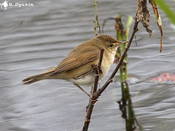search
classification
|
basic information
|
Blyth's Reed Warbler
Acrocephalus dumetorum (Blyth, 1849)

|

|
|
|
2011-06-25
Krasnoyarsky Kray. Kozulka. |
© Igor Latysh
|
|
Description
The Blyth's Reed Warbler is a medium-sized warbler (less than Sparrow); without dark mottles and streaks. The upperparts are plain olive-brown, sometimes with buffy or rusty tinge, especially expressed on rump. It is distinguished from the Marsh Warbler by the "colder" grey or olive coloring; light supercilium extends over the eye, is more expressed than light eye ring; light edges of the flight feathers are slightly marked. From the Eurasian Reed Warbler it is distinguished by same features and by absence of buffy tinge on the flanks. From Paddyfield Warbler it is distinguished by the slimmer constitution; by absence of rusty color on rump; by narrower, dimmer and shorter supercilium. The legs may be as dark (grey, brownish) and light (buffy, buffy-brownish). The seasonal differences of plumage are insignificant, after the summer molting birds become "warmer", rustier, especially on the wings and rump. Sexes are similar. Juveniles are not sure distinguished from adults by the more rustier tone, especially on the wings ad rump. The contact characters: 1st primary is not longer or slightly longer (on 1-2 mm) than wing coverts; 2nd primary is shorter than 5th one; on folded wing the primaries projection is less than 15 mm; claw of rear finger is shorter than finger; bill length 88,8-10,0 mm. Weight 9-15 grams, length about 13, wing 5,9-6,7, wingspan 17-19 cm.
Biology
The Blyth's Warbler is abundant breeding migrant, in places passage migrant only. It inhabits the bush thickets near the rivers, lakes and marshes, on the meadow and rarely in tall grass with some bushes, both on plain and in mountains up to 2000 m. On migration it visits various forests, bushes, gardens, groves, forest-belts, reed beds, lucerne fields and tall weeds thickets. In southern areas it appears in end April – early May; and in early – mid-May in northern ones and in mountains. The latest spring migrants recorded in early June. It breeds in separate pairs, at 25-100 m one from another. Nest is built in bush (willow, currant, raspberry, honeysuckle, birch, dog-rose) or in tall grass (nettle, willow-herb, blackberry, reed); from the dry grass, cobweb and vegetation fluff; and sometimes is lined with hair. Clutches of 3-6 (usually 5) eggs is in late May – mid-July. Both parents feed juveniles, which fledge at 11-12 days old, in end June – mid-August. Autumn migration begins in late July, majority of the birds migrate in August; latest migrants recorded in mid-October.
References














